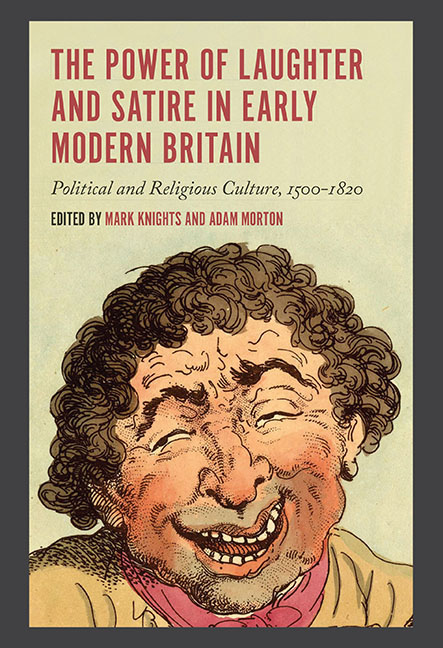Book contents
- Frontmatter
- Contents
- List of Illustrations
- List of Contributors
- Acknowledgements
- List of Abbreviations
- Introduction: Laughter and Satire in Early Modern Britain 1500–1800
- 1 Dissolving into Laughter: Anti-Monastic Satire in the Reign of Henry VIII
- 2 Mocking or Mirthful? Laughter in Early Modern Dialogue
- 3 Farting in the House of Commons: Popular Humour and Political Discourse in Early Modern England
- 4 Continuing Civil War by Other Means: Loyalist Mockery of the Interregnum Church
- 5 Laughter as a Polemical Act in Late Seventeenth-Century England
- 6 Spectacular Opposition: Suppression, Deflection and the Performance of Contempt in John Gay's Beggar's Opera and Polly
- 7 ‘Laughing a Folly out of Countenance’: Laughter and the Limits of Reform in Eighteenth-Century Satire
- 8 Nervous Laughter and the Invasion of Britain 1797–1805
- 9 ‘Was a laugh treason?’ Corruption, Satire, Parody and the Press in Early Modern Britain
- Bibliography
- Index
Introduction: Laughter and Satire in Early Modern Britain 1500–1800
Published online by Cambridge University Press: 01 September 2018
- Frontmatter
- Contents
- List of Illustrations
- List of Contributors
- Acknowledgements
- List of Abbreviations
- Introduction: Laughter and Satire in Early Modern Britain 1500–1800
- 1 Dissolving into Laughter: Anti-Monastic Satire in the Reign of Henry VIII
- 2 Mocking or Mirthful? Laughter in Early Modern Dialogue
- 3 Farting in the House of Commons: Popular Humour and Political Discourse in Early Modern England
- 4 Continuing Civil War by Other Means: Loyalist Mockery of the Interregnum Church
- 5 Laughter as a Polemical Act in Late Seventeenth-Century England
- 6 Spectacular Opposition: Suppression, Deflection and the Performance of Contempt in John Gay's Beggar's Opera and Polly
- 7 ‘Laughing a Folly out of Countenance’: Laughter and the Limits of Reform in Eighteenth-Century Satire
- 8 Nervous Laughter and the Invasion of Britain 1797–1805
- 9 ‘Was a laugh treason?’ Corruption, Satire, Parody and the Press in Early Modern Britain
- Bibliography
- Index
Summary
This volume argues that laughter and satire played significant roles in political processes and social practices in a range of historical contexts in early modern Britain. Their role was contradictory and ambiguous: laughter and satire both defined or solidified communal boundaries by confronting those who breached social mores and offered potent ways to challenge and corrode those boundaries. Satire did not necessarily provoke laughter, and not all laughter was satirical, but the two were often closely intertwined even though they had slightly separate histories and purposes: both raised questions about when they were appropriate and, as a result, both occupied a highly ambiguous and contested space. Both could foster common identities whilst at the same time being capable of dividing, attacking and subverting those identities, cultural assumptions or political and religious positions. Indeed, this vibrant duality, constructive and destructive, and the fundamental ambiguity about when laughter was appropriate, are reflected in the linguistic inventiveness of the early modern period, when new words to describe types of laughter were forged or when old words acquired new meanings.
To understand what past cultures laughed at, and why they found certain types of laughter objectionable in certain contexts, is to open a window onto the social mores and assumptions of those cultures: to understand in what ways they are both familiar and unfamiliar to us. Because laughter is an instant reaction, it speaks to the heart of those mores. In the words of Robert Darnton: ‘When you realise that you are not getting something – a joke, a proverb, a ceremony – that is particularly meaningful to the natives, you can see where to grasp a foreign system of meaning in order to unravel it.’ Getting the joke helps us to ‘get’ at fundamental assumptions in a given society or culture.
- Type
- Chapter
- Information
- The Power of Laughter and Satire in Early Modern BritainPolitical and Religious Culture, 1500-1820, pp. 1 - 26Publisher: Boydell & BrewerPrint publication year: 2017

